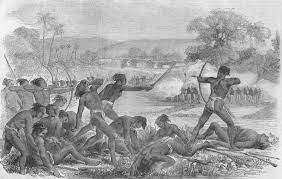The Santhal Rebellion was one of the most significant tribal uprisings in India’s colonial history. It took place in the mid-19th century and was led by the Santhal community, a tribal group predominantly inhabiting the region now known as Jharkhand. The rebellion was a response to the exploitative and oppressive policies of the British colonial administration, as well as the encroachment on their ancestral lands and traditional way of life.

Table of Contents
The Historical Background
During the 19th century, the British East India Company expanded its control across India, imposing its rule on various regions and communities. This period of colonial domination witnessed the systematic marginalization of tribal communities like the Santhals. The British introduced new land policies and revenue systems, dispossessing the Santhals of their ancestral lands and traditional rights. These policies disrupted their agrarian practices and subjected them to exploitation by landlords and moneylenders.
Causes of the Rebellion
- Land Dispossession: The British implemented the Zamindari system, transferring land rights to intermediaries, leading to the loss of land by the Santhal community and exploitation by these intermediaries.
- Forced Labor and Indigo Cultivation: The British promoted indigo cultivation, which required large areas of land and cheap labor. Santhal farmers were coerced into cultivating indigo under oppressive conditions.
- Economic Exploitation: Moneylenders and traders took advantage of the Santhals’ dire economic circumstances, trapping them in cycles of debt and bonded labor.
- Socio-cultural Erosion: The imposition of British laws and regulations eroded the traditional social and cultural fabric of the Santhal community, leading to widespread discontent.
Outbreak Santhal Rebellion
In June 1855, the Santhal Rebellion erupted as a spontaneous uprising against the injustices and hardships faced by the community. Led by Sidhu and Kanhu Murmu, the rebellion quickly spread through the Santhal regions, uniting thousands of Santhal tribespeople in their fight for justice and liberation.
The Santhals adopted guerilla warfare tactics, attacking symbols of British authority, including police stations, revenue offices, and colonial agents. They also targeted exploitative landlords and moneylenders, reclaiming their land and resources.
The British Response and Suppression
The British colonial administration responded harshly to the rebellion. They deployed military forces to quell the uprising, launching campaigns to crush the Santhals’ resistance. Despite the Santhals’ bravery and fighting spirit, they were eventually outnumbered and outgunned by the British forces.
Impact of Santhal Rebellion
The suppression of the Santhal Rebellion resulted in severe consequences for the tribal community. The British authorities executed several Santhal leaders, and many more were arrested or killed during the conflict. The rebels faced brutal reprisals, leading to further marginalization and exploitation of the Santhals.
Despite their military defeat, the Santhal Rebellion left a lasting impact on India’s struggle for independence. It highlighted the resilience and determination of India’s tribal communities in their fight against colonial oppression. The rebellion inspired other tribal groups across India to resist British rule and fight for their rights and autonomy.
Legacy of Santhal Rebellion
The Santhal Rebellion remains an essential part of India’s history of anti-colonial struggles. In independent India, the rebellion is commemorated as a symbol of the resistance and resilience of tribal communities against injustice and exploitation. It serves as a reminder of the need to recognize and protect the rights and heritage of India’s indigenous peoples.
Conclusion
The Santhal Rebellion stands as a significant chapter in India’s colonial history, showcasing the strength and courage of the Santhal community in their struggle for justice and autonomy. The rebellion continues to inspire generations to come, encouraging the recognition of India’s diverse and vibrant tribal heritage and the importance of protecting the rights and dignity of its indigenous communities. As India moves forward, the lessons learned from the Santhal Rebellion serve as a constant reminder of the value of upholding justice, inclusivity, and respect for all its citizens, regardless of their background or heritage.
Important Links